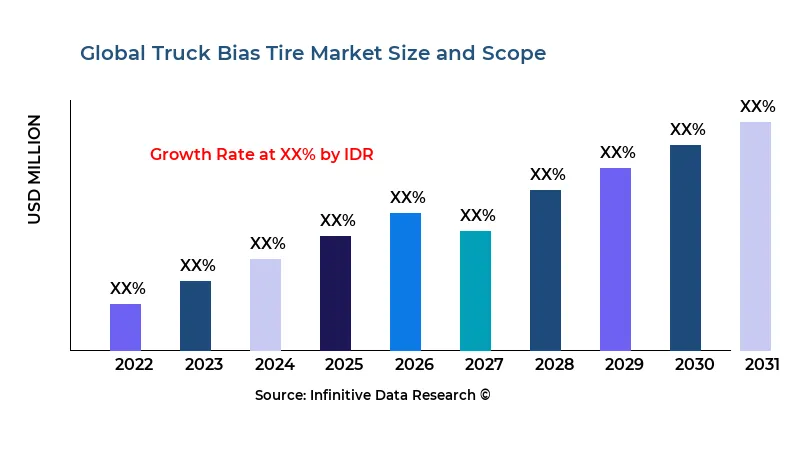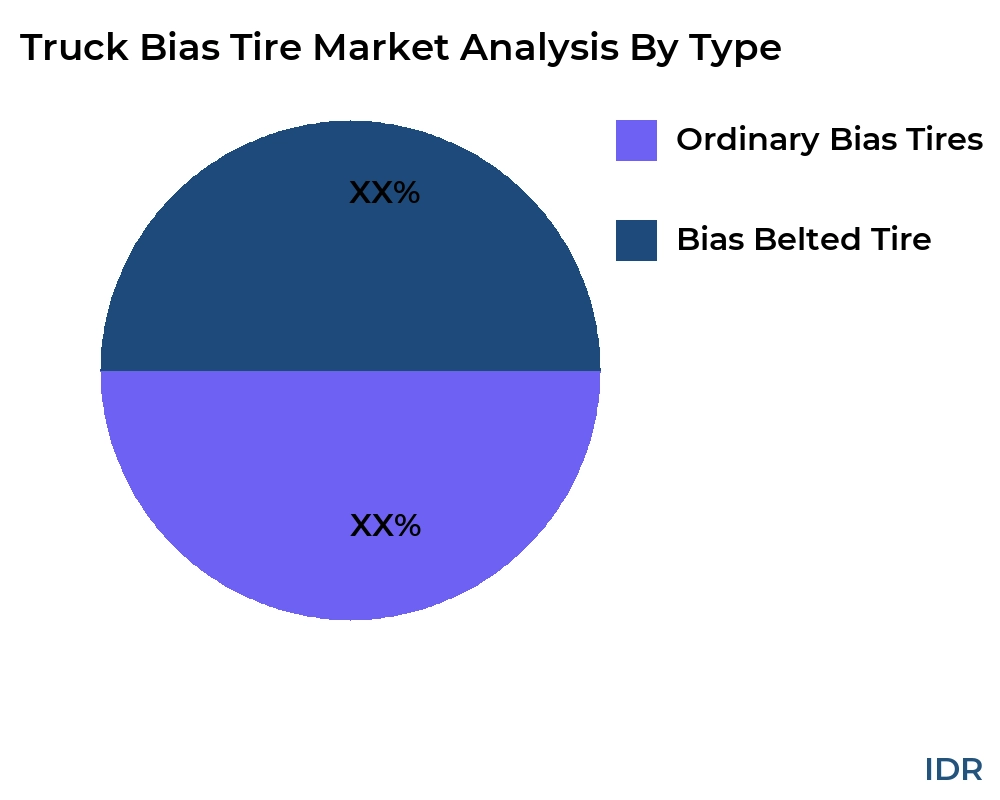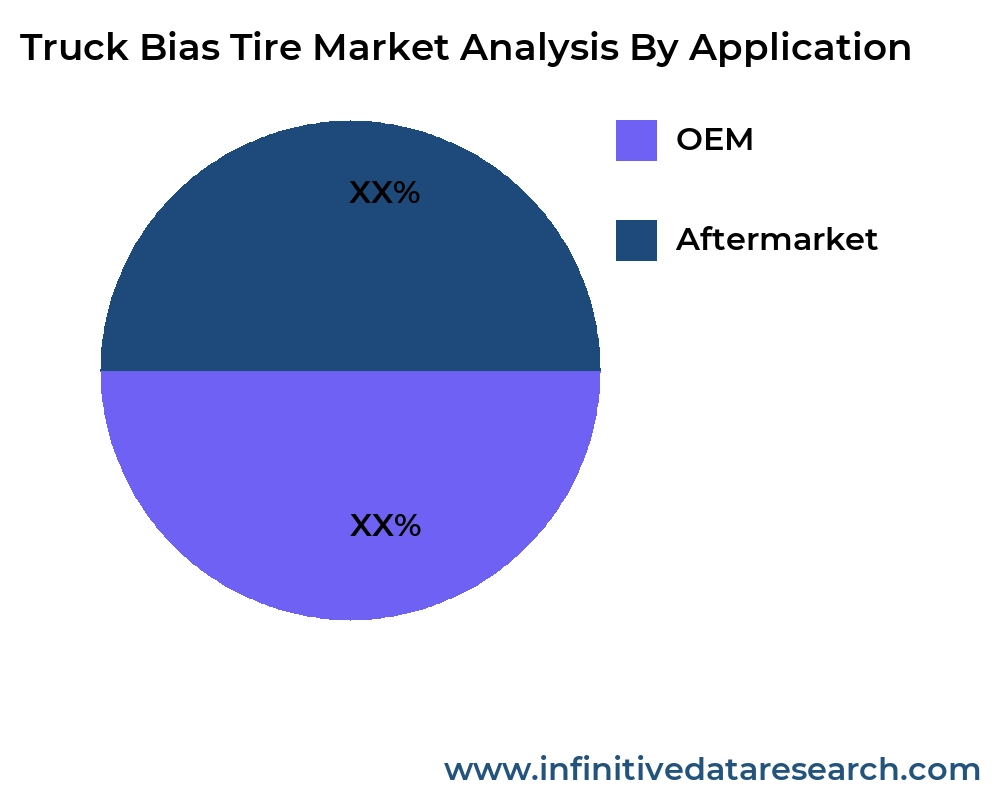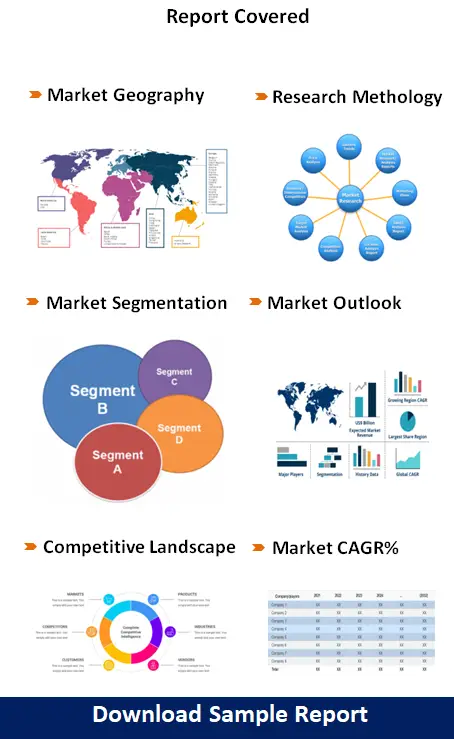Truck Bias Tire Market Growth CAGR Overview
According to research by Infinitive Data Research, the global Truck Bias Tire Market size was valued at USD 3.4 Bln (billion) in 2024 and is Calculated to reach USD 4.3 Bln (billion) by the end of 2032, growing at an anticipated compound annual growth rate (CAGR) of 6.8% during the forecast period 2024 to 2032. This projected growth is driven by its increasing adoption across Automotive industries such as OEM, AftermarketThe Truck Bias Tire market is defined by a focus on reliability and cost efficiency in applications where traditional tire technology remains practical and preferred. Manufacturers continue to produce bias truck tires that offer rugged construction, simpler repair methods, and proven performance in moderate load conditions. While the market is gradually evolving, many fleet operators in cost-sensitive regions still favor bias tires because of their lower replacement costs and established legacy support infrastructures. This persistence is supported by long-term relationships with regional distributors and a well-understood maintenance methodology.
Market dynamics in this sector revolve around the balance between maintaining proven performance characteristics and introducing subtle technological improvements. Even though the broader tire industry is shifting toward radials, manufacturers of truck bias tires are increasingly utilizing modest upgrades in materials and construction techniques to extend tire life and reduce overall costs. The focus remains on fundamental attributes like wear resistance and ease of repair, which are highly valued by operators managing older or specialized fleets. These factors work together to sustain a niche yet dedicated market segment.
Competition in the Truck Bias Tire market is typically less intense than in more technologically advanced segments. Here, established players rely on their long-term reputations, local market knowledge, and established dealer networks to retain customer loyalty. Incremental improvements and cost optimizations have provided a steady pathway for maintaining market share. The interplay of tradition and gradual modernization influences the competitive landscape, allowing smaller regional producers to compete effectively with larger global brands through personalized service and tailored product offerings.
Distribution and service networks remain a cornerstone for competitive performance in the Truck Bias Tire market. The reliance on regional technical support, well-organized supply chains, and long-standing customer relationships ensures that product quality and availability remain steady. This network serves as a critical competitive advantage for companies that cater to fleets with established maintenance practices. Overall, the market dynamics highlight a stable environment where modest innovation and a focused service strategy help maintain the market’s viability.

>>> Understand The Key Trends Shaping This Market:- Download PDF Sample
Truck Bias Tire Market Growth Factors
Increases in regional freight demand and sustained use of older truck models continue to drive growth within the Truck Bias Tire market. Fleet operators in emerging markets, where the cost of transitioning to radial technology may be prohibitive, prefer bias tires due to their lower upfront investment and proven reliability. The market benefits from steady demand spurred by budget constraints and the need to keep transportation costs predictable. This growth is reinforced by consistent fleet renewal cycles in cost-sensitive segments.
Technological enhancements, even if incremental, have significantly contributed to extending the lifespan of truck bias tires. Improvements in rubber compounds and manufacturing processes have yielded tires that are more resistant to wear and better able to withstand moderate loads. These modest innovations reduce replacement frequency, lower maintenance costs, and build a business case for continued use in specific applications. As performance metrics improve gradually, fleet operators are incentivized to retain their long-standing purchasing preferences, further driving market expansion.
Enhanced distribution networks and service infrastructures have also played a critical role in sustaining market growth. Regional partnerships, direct sales channels, and local service centers ensure that supply meets demand in areas where bias tires continue to be favored. Enhanced logistical efficiency, coupled with cost-effective pricing strategies, supports stable market conditions. These improvements directly benefit fleet operators who rely on timely replacements and dependable technical support, thereby propelling continuous market momentum.
Government incentives and an emphasis on maintaining reliable, cost-effective transportation in certain regions further bolster market growth. In areas with limited modernization of transport fleets, policies that emphasize affordability and proven performance contribute to a steady demand. Regulatory environments that acknowledge the economic realities of smaller-scale operations help preserve the market for bias tire technologies. Combined with customer loyalty and regionally tailored marketing efforts, these factors provide a robust foundation for sustained expansion.
Market Analysis By Competitors
- Michelin
- Bridgestone
- Continental
- Pirelli
- Goodyear
- Shanghai Huayi
- Sumitomo Rubber Industries
- ZC Rubber
- Yokohama
- Nokian Tyres
- Hankook
- Maxxis
- Triangle Group
By Product Type
- Ordinary Bias Tires
- Bias Belted Tire
By Application
- OEM
- Aftermarket
>>> Understand The Key Trends Shaping This Market:- Understand The Key Trends Shaping This Market:-
Truck Bias Tire Market Segment Analysis
Distribution Channel:
The distribution channels for truck bias tires rely extensively on established regional networks that encompass direct sales, local dealers, and service centers. These channels have evolved from decades of traditional trade relationships that place a premium on personalized service and technical support. Regional distributors, often with a deep understanding of local operating conditions, ensure that products are available where cost-effective maintenance and immediate repairs are essential. This age-old system is now gradually supported by emerging digital sales initiatives that cater to operators in regions where traditional channels have long dominated.
Compatibility:
Compatibility in the truck bias tire market is key in ensuring that these tires can effectively serve older truck models and regional fleets with established mechanical systems. Manufacturers test their products extensively to ensure consistent performance under varied regional road conditions and load requirements. The tires are designed to be easily integrated into fleets that have standardized on bias tire technology, providing essential performance in conditions that demand reliability over the latest high-tech features. This compatibility is crucial for fleet operators who depend on predictability and simplicity in their maintenance routines.
Price Range:
The price range in the truck bias tire market is strategically positioned to offer budget-friendly alternatives in environments where cost control is paramount. Bias tires in this segment are generally priced lower than their modern radial counterparts, appealing to operators who prioritize initial cost and overall maintenance affordability. By keeping production costs in check and enhancing the durability of their offerings, manufacturers are able to provide products that maintain a competitive price-to-performance ratio. This pricing strategy meets the specific needs of fleet operators who are evaluating the total cost of ownership over extended periods.
Product Type:
Product type segmentation within the truck bias tire market is focused on addressing varying performance requirements such as longevity, wear resistance, and load capacity. Manufacturers develop multiple variants tailored for different trucking applications—from urban delivery trucks to regional freight transport vehicles operating under moderate conditions. Each product variation is designed to optimize fundamental aspects of performance, ensuring that the tires meet stringent standards even in legacy applications. This diversity in product offerings helps capture a broad range of customer needs and reinforces the niche market position of bias tire technology.
| REPORT ATTRIBUTES | DETAILS |
|---|---|
| Study Period |
2019-2032 |
| Base Year |
2023 |
| Forecast Period |
2024-2032 |
| Historical Period |
2019-2022 |
| Unit |
Value (USD Billion) |
| Key Companies Profiled |
Michelin, Bridgestone, Continental, Pirelli, Goodyear, Shanghai Huayi, Sumitomo Rubber Industries, ZC Rubber, Yokohama, Nokian Tyres, Hankook, Maxxis, Triangle Group |
| Segments Covered |
By Product |
| Customization Scope |
Free report customization (equivalent to up to 3 analyst working days) with purchase. Addition or alteration to country, regional and segment scope |
>>> Overview of Market Analysis:- Download PDF Sample
Truck Bias Tire Market Regional Analysis
In North America, the truck bias tire market is primarily driven by regional transport operators who maintain older fleets and prioritize cost-effective solutions. The market benefits from extensive service networks and technical expertise that support the maintenance of traditional tire technology. Although advanced radial technologies dominate most segments, niche demand persists due to the stability of legacy systems and established repair practices. This region’s competitive advantage lies in its well-developed distribution and customer support systems.
European markets for truck bias tires are more limited, as technological shifts have largely moved the industry towards radial solutions. However, in certain rural or economically constrained areas, older truck fleets still rely on bias tires. Local manufacturers and distributors have adapted by providing products that meet specific regulatory and operational needs. This tailored market approach allows a persistent but small niche for bias tires to continue, supported by established service chains and price-sensitive logistics operators.
The Asia-Pacific region presents a mixed picture where modernization is progressing unevenly across markets. In rapidly modernizing urban centers, radial tires are becoming dominant, yet in rural and semi-urban areas, the relatively lower cost of bias tires sustains demand. Local economic factors, coupled with traditional service infrastructure, allow bias tire manufacturers to maintain a foothold in these regions. The market is characterized by diversity in fleet compositions and an ongoing reliance on tried-and-tested technology amid broader modernization trends.
Latin America and Africa offer considerable potential for truck bias tires, primarily due to the prevalence of older vehicles and limited financial capacity for rapid fleet upgrades. Here, the demand for reliable and economical tire solutions is high, as cost constraints and established market practices favor simpler, proven technologies. Local distributors and manufacturers continue to support these markets with products that meet minimal operational thresholds. The steady demand in these regions is bolstered by supportive regional infrastructure and an emphasis on maintaining dependable transportation systems.
global Truck Bias Tire market revenue (usd million) comparison by players 2024-2032
| Company/players | 2021 | 2022 | 2023 | 2024 | ... | (2032) |
|---|---|---|---|---|---|---|
| Michelin | XX | XX | XX | XX | XX | XX |
| Bridgestone | XX | XX | XX | XX | XX | XX |
| Continental | XX | XX | XX | XX | XX | XX |
| Pirelli | XX | XX | XX | XX | XX | XX |
| Goodyear | XX | XX | XX | XX | XX | XX |
| Shanghai Huayi | XX | XX | XX | XX | XX | XX |
| Sumitomo Rubber Industries | XX | XX | XX | XX | XX | XX |
| ZC Rubber | XX | XX | XX | XX | XX | XX |
| Yokohama | XX | XX | XX | XX | XX | XX |
| Nokian Tyres | XX | XX | XX | XX | XX | XX |
| Hankook | XX | XX | XX | XX | XX | XX |
| Maxxis | XX | XX | XX | XX | XX | XX |
| Triangle Group | XX | XX | XX | XX | XX | XX |
| Total | XX | XX | XX | XX | XX | XX |
global Truck Bias Tire market revenue (usd million) comparison by product type 2024-2032
Product Type
2023
2024
...
2032
CAGR%(2024-32)
Ordinary Bias Tires
XX
XX
XX
XX
XX
Bias Belted Tire
XX
XX
XX
XX
XX
Total
XX
XX
XX
XX
XX
| Product Type | 2023 | 2024 | ... | 2032 | CAGR%(2024-32) |
|---|---|---|---|---|---|
| Ordinary Bias Tires | XX | XX | XX | XX | XX |
| Bias Belted Tire | XX | XX | XX | XX | XX |
| Total | XX | XX | XX | XX | XX |
global Truck Bias Tire market revenue (usd million) comparison by application 2024-2032
Application
2023
2024
...
2032
CAGR%(2024-32)
OEM
XX
XX
XX
XX
XX
Aftermarket
XX
XX
XX
XX
XX
Total
XX
XX
XX
XX
XX
| Application | 2023 | 2024 | ... | 2032 | CAGR%(2024-32) |
|---|---|---|---|---|---|
| OEM | XX | XX | XX | XX | XX |
| Aftermarket | XX | XX | XX | XX | XX |
| Total | XX | XX | XX | XX | XX |
>>> Market Understand Through Graph And Chart:- Download PDF Sample


Truck Bias Tire Market Competitive Insights
Competition within the Truck Bias Tire market is notably less dynamic than in markets transitioning to advanced tire technologies. Established brands continue to maintain their presence by relying on long-term customer relationships and proven product performance. The competitive strategies focus more on cost leadership, reliability, and consistent after-sales support rather than on breakthrough innovations. These companies have built deep roots in regional markets where predictable and maintainable performance remains the norm, creating a stable yet modestly competitive environment.
Market leaders in this segment derive significant strength from longstanding technical support networks and regional service centers that foster customer loyalty. The emphasis on legacy performance means that even small improvements in production efficiency and reliability can serve as key differentiators. While product innovation is more incremental compared to rapidly evolving segments, the focus on tight cost control and dependable output ensures that established brands continue to command significant market share. Competitive efforts are centered around maintaining a reputation for reliable, cost-effective solutions.
Smaller regional players compete by leveraging localized expertise and flexible distribution strategies. These companies are nimble in their approach and often customize their product offerings to suit local market conditions and customer requirements. Their competitive advantage lies in the ability to react quickly to market changes and to foster long-term relationships with customers who prefer traditional products. This localized focus helps smaller firms effectively challenge larger companies on the basis of service and economic suitability in niche markets.
Digital modernization is slowly penetrating the truck bias tire market, with some companies investing in digital platforms to improve inventory management and customer engagement. Although the overall industry focus remains on traditional performance and cost advantages, emerging trends in digital transformation are beginning to affect competitive dynamics. Enhanced online support systems and data-driven service improvements are gradually being integrated into existing sales channels, providing incremental benefits that further secure market positioning. This gradual shift reinforces the importance of balancing tradition with selective modernization in the competitive landscape.
Truck Bias Tire Market Competitors
United States
-
Goodyear Tire & Rubber Company
-
Bridgestone Americas
-
Michelin North America
-
Continental Tire the Americas
-
Cooper Tire & Rubber Company
Germany
-
Continental AG
-
Michelin Deutschland
-
Pirelli Deutschland
-
Bridgestone Europe
-
Goodyear Dunlop
Japan
-
Bridgestone Corporation
-
Yokohama Rubber Company
-
Dunlop Japan
-
Toyo Tire & Rubber Co. Ltd.
-
Sumitomo Rubber Industries
China
-
Linglong Tire
-
Double Coin Holdings
-
Aeolus Tyre Co. Ltd.
-
Sailun Group Co. Ltd.
-
Zhongce Rubber Group
India
-
MRF Tyres
-
Apollo Tyres
-
Ceat Limited
-
JK Tyre & Industries
-
TVS Srichakra
South Korea
-
Hankook Tire
-
Kumho Tire
-
Nexen Tire
-
Hankook Ventus Division
-
Kumho Asiana Corporation
Truck Bias Tire Market Top Competitors
Bridgestone Corporation
Bridgestone Corporation commands the truck bias tire market with a long-standing reputation for durability and efficiency. Its production techniques ensure that every tire meets stringent reliability standards suitable for legacy applications. The company’s extensive distribution and service networks enhance its regional market presence, ensuring timely support to fleet operators. Strategic cost management and consistent product performance are central to its competitive approach. This reliable track record solidifies Bridgestone’s leadership in traditional truck tire segments.
Michelin North America
Michelin North America continues to be a preferred supplier in the truck bias tire market due to its focus on balanced performance and cost effectiveness. The company maintains robust quality control measures that ensure its products deliver predictable performance over extended usage periods. Its emphasis on customer service and regional support networks ensures high customer loyalty among cost-sensitive fleets. Michelin’s ability to adapt traditional technologies with incremental improvements reinforces its market position. Its commitment to value and reliability makes it a key player in this niche segment.
Goodyear Tire & Rubber Company
Goodyear Tire & Rubber Company leverages decades of experience to manufacture truck bias tires that meet the fundamental needs of traditional fleet operators. Its proven manufacturing processes and well-established service networks enhance product reliability and customer satisfaction. Goodyear’s focus on dependable performance, combined with cost control and extensive after-sales support, provides significant competitive advantages. The company’s legacy and continuous incremental improvements further solidify its position in the market. These efforts ensure that Goodyear remains a trusted name in the traditional truck tire space.
Continental AG
Continental AG applies its engineering expertise to produce bias tires that deliver consistent performance in rugged operating conditions. The company’s emphasis on precision construction and quality assurance ensures that its products are well-suited for trucks with established maintenance practices. With a global supply chain that emphasizes timely service, Continental AG provides a reliable option for cost-conscious fleet operators. Its strategies for maintaining product quality and value translate into sustained customer loyalty. This unwavering focus on reliability defines its competitive strength in the market.
Pirelli Deutschland
Pirelli Deutschland adapts premium manufacturing standards to serve the niche market of truck bias tires, focusing on cost-effective production and durability. Its products are engineered to sustain long-term use under moderate load conditions, making them ideal for established fleets. Pirelli emphasizes efficiency in production and logistics to ensure a competitive price point without sacrificing quality. The company’s deep understanding of regional market demands enables it to tailor its offerings for maximum reliability and affordability. This approach secures its position as a key competitor in the legacy truck tire segment.
Dunlop Japan
Dunlop Japan combines a rich heritage with modern production efficiencies to deliver truck bias tires that offer high value in cost-sensitive markets. Its focus is on providing reliable performance without the premium associated with newer technologies. With robust testing and established service channels, Dunlop Japan is well respected for its traditional product excellence. Its localized approach and commitment to affordability enable it to effectively compete with larger multinationals in targeted segments. This steadfast focus on reliability reinforces its market presence.
Yokohama Rubber Company
Yokohama Rubber Company distinguishes itself by emphasizing durable construction and consistent performance in its truck bias tire offerings. Its products are designed to deliver reliable service under the operating conditions typical of legacy truck fleets. The company’s continuous effort to refine traditional production methods results in enhanced tire longevity and predictable performance. Yokohama’s strong regional distribution and after-sales support further secure its position in niche markets. Its reputation for steadfast quality underscores its competitive advantage.
Sumitomo Rubber Industries
Sumitomo Rubber Industries leverages traditional production techniques combined with targeted quality enhancements to produce truck bias tires that perform reliably under heavy use. The company’s commitment to cost-effectiveness and routine performance improvements has secured its foothold in legacy market segments. Sumitomo’s advanced production control and efficient service networks ensure that its products meet the steady demands of regional fleets. Its ongoing focus on reliable performance and economical production maintains its competitive standing. This pragmatic approach positions Sumitomo as a trusted supplier in the market.
Ceat Limited
Ceat Limited offers a line of truck bias tires that balance cost, durability, and maintenance ease for traditional fleet operations. The company’s focus on economical production enables it to deliver products at competitive price points while ensuring consistent performance. Ceat invests in incremental product enhancements that extend tire life and reduce operational costs, making its offerings attractive in budget-conscious segments. Its extensive service network and localized support systems further boost customer trust. This customer-centric strategy reinforces its competitive position in the legacy truck tire market.
JK Tyre & Industries
JK Tyre & Industries focuses on integrating affordability with sufficient performance in its truck bias tire products. The company tailors its production processes to meet the specific needs of cost-sensitive fleet operators in regional markets. Its continuous process improvements and effective customer service practices result in reliable tire performance and strong market acceptance. JK Tyre’s ability to maintain cost efficiency without compromising quality helps it stay competitive in its niche. This focus on value and consistency makes it a respected name among traditional truck tire suppliers.
The report provides a detailed analysis of the Truck Bias Tire market across various regions, highlighting the unique market dynamics and growth opportunities in each region.
- US
- Canada
- Mexico
- UK
- Germany
- France
- Italy
- Russia
- Spain
- Switzerland
- Austria
- Belgium
- Rest of Europe
- China
- Japan
- South Korea
- Indonesia
- Vietnam
- Philippines
- Australia
- Thailand
- Singapore
- Rest of APAC
- UAE
- Saudi Arabia
- Egypt
- South Africa
- Israel
- Rest of MEA
- Brazil
- Argentina
- Rest of Latin America
>>> Need A Different Region Or Segment? Download PDF Sample
Key Takeaways
- The global Truck Bias Tire market is expected to grow significantly from 2024 to 2032, driven by technological advancements, increasing demand, and government investments in urbanization.
- The market is characterized by a diverse range of manufacturers, product types, and applications, catering to different consumer needs and preferences.
- Regional insights highlight the unique market dynamics and growth opportunities in various regions, including North America, Europe, Asia-Pacific, Latin America, and the Middle East & Africa.
- The competitive landscape features key players who have created a dynamic and diverse market environment through collaborations, mergers and acquisitions, and innovative product developments.
- Market trends such as technological advancements, sustainability, customization, and digital transformation are shaping the growth and development of the Truck Bias Tire market.
- Despite the positive outlook, the market faces challenges such as regulatory compliance, high initial investment costs, and economic uncertainties.
- The report provides comprehensive coverage of market size, market share, growth factors, and strategic insights to help businesses navigate the dynamic Truck Bias Tire market and achieve long-term success.
By leveraging the information provided in this report, businesses can develop effective strategies, address market challenges, and capitalize on growth opportunities to ensure sustainable growth and long-term success in the global Truck Bias Tire market.
- Introduction
- Objectives of the Study
- Market Definition
- Research Scope
- Currency
- Key Target Audience
- Research Methodology and Assumptions
- Executive Summary
- Premium Insights
- Porter’s Five Forces Analysis
- Value Chain Analysis
- Top Investment Pockets
- Industry Trends
- Market Dynamics
- Market Evaluation
- Drivers
- Restraints
- Opportunities
- Challenges
- Global Truck Bias Tire Market Analysis and Projection, By Companies
- Segment Overview
- Michelin
- Bridgestone
- Continental
- Pirelli
- Goodyear
- Shanghai Huayi
- Sumitomo Rubber Industries
- ZC Rubber
- Yokohama
- Nokian Tyres
- Hankook
- Maxxis
- Triangle Group
- Global Truck Bias Tire Market Analysis and Projection, By Type
- Segment Overview
- Ordinary Bias Tires
- Bias Belted Tire
- Global Truck Bias Tire Market Analysis and Projection, By Application
- Segment Overview
- OEM
- Aftermarket
- Global Truck Bias Tire Market Analysis and Projection, By Regional Analysis
- North America
- US
- Canada
- Mexico
- Europe
- UK
- Germany
- France
- Italy
- Russia
- Spain
- Switzerland
- Austria
- Belgium
- Rest of Europe
- Asia Pacific
- China
- Japan
- South Korea
- Indonesia
- Vietnam
- Philippines
- Australia
- Thailand
- Singapore
- Rest of APAC
- Middle East
- UAE
- Saudi Arabia
- Egypt
- South Africa
- Israel
- Rest of MEA
- Latin America
- Brazil
- Argentina
- Rest of Latin America
- Global Truck Bias Tire Market-Competitive Landscape
- Overview
- Market Share of Key Players in the Truck Bias Tire Market
- Global Company Market Share
- North America Company Market Share
- Europe Company Market Share
- APAC Company Market Share
- Competitive Situations and Trends
- Coverage Launches and Developments
- Partnerships, Collaborations, and Agreements
- Mergers & Acquisitions
- Expansions
- Company Profiles
- Michelin
- Business Overview
- Company Snapshot
- Company Market Share Analysis
- Company Coverage Portfolio
- Recent Developments
- SWOT Analysis
- Bridgestone
- Business Overview
- Company Snapshot
- Company Market Share Analysis
- Company Coverage Portfolio
- Recent Developments
- SWOT Analysis
- Continental
- Business Overview
- Company Snapshot
- Company Market Share Analysis
- Company Coverage Portfolio
- Recent Developments
- SWOT Analysis
- Pirelli
- Business Overview
- Company Snapshot
- Company Market Share Analysis
- Company Coverage Portfolio
- Recent Developments
- SWOT Analysis
- Goodyear
- Business Overview
- Company Snapshot
- Company Market Share Analysis
- Company Coverage Portfolio
- Recent Developments
- SWOT Analysis
- Shanghai Huayi
- Business Overview
- Company Snapshot
- Company Market Share Analysis
- Company Coverage Portfolio
- Recent Developments
- SWOT Analysis
- Sumitomo Rubber Industries
- Business Overview
- Company Snapshot
- Company Market Share Analysis
- Company Coverage Portfolio
- Recent Developments
- SWOT Analysis
- ZC Rubber
- Business Overview
- Company Snapshot
- Company Market Share Analysis
- Company Coverage Portfolio
- Recent Developments
- SWOT Analysis
- Yokohama
- Business Overview
- Company Snapshot
- Company Market Share Analysis
- Company Coverage Portfolio
- Recent Developments
- SWOT Analysis
- Nokian Tyres
- Business Overview
- Company Snapshot
- Company Market Share Analysis
- Company Coverage Portfolio
- Recent Developments
- SWOT Analysis
- Hankook
- Business Overview
- Company Snapshot
- Company Market Share Analysis
- Company Coverage Portfolio
- Recent Developments
- SWOT Analysis
- Maxxis
- Business Overview
- Company Snapshot
- Company Market Share Analysis
- Company Coverage Portfolio
- Recent Developments
- SWOT Analysis
- Triangle Group
- Business Overview
- Company Snapshot
- Company Market Share Analysis
- Company Coverage Portfolio
- Recent Developments
- SWOT Analysis
List of Table
- Drivers of Global Truck Bias Tire Market: Impact Analysis
- Restraints of Global Truck Bias Tire Market: Impact Analysis
- Global Truck Bias Tire Market, By Technology, 2023-2032(USD Billion)
- global Ordinary Bias Tires, Truck Bias Tire Market, By Region, 2023-2032(USD Billion)
- global Bias Belted Tire, Truck Bias Tire Market, By Region, 2023-2032(USD Billion)
- global OEM, Truck Bias Tire Market, By Region, 2023-2032(USD Billion)
- global Aftermarket, Truck Bias Tire Market, By Region, 2023-2032(USD Billion)
List of Figures
- Global Truck Bias Tire Market Segmentation
- Truck Bias Tire Market: Research Methodology
- Market Size Estimation Methodology: Bottom-Up Approach
- Market Size Estimation Methodology: Top-down Approach
- Data Triangulation
- Porter’s Five Forces Analysis
- Value Chain Analysis
- Top investment pocket in the Truck Bias Tire Market
- Top Winning Strategies, 2023-2032
- Top Winning Strategies, By Development, 2023-2032(%)
- Top Winning Strategies, By Company, 2023-2032
- Moderate Bargaining power of Buyers
- Moderate Bargaining power of Suppliers
- Moderate Bargaining power of New Entrants
- Low threat of Substitution
- High Competitive Rivalry
- Restraint and Drivers: Truck Bias Tire Market
- Truck Bias Tire Market Segmentation, By Technology
- Truck Bias Tire Market For Live Attenuated, By Region, 2023-2033 ($ Billion)
- Global Truck Bias Tire Market, By Technology, 2023-2032(USD Billion)
- global Ordinary Bias Tires, Truck Bias Tire Market, By Region, 2023-2032(USD Billion)
- global Bias Belted Tire, Truck Bias Tire Market, By Region, 2023-2032(USD Billion)
- global OEM, Truck Bias Tire Market, By Region, 2023-2032(USD Billion)
- global Aftermarket, Truck Bias Tire Market, By Region, 2023-2032(USD Billion)
- Michelin: Net Sales, 2023-2033 ($ Billion)
- Michelin: Revenue Share, By Segment, 2023 (%)
- Michelin: Revenue Share, By Region, 2023 (%)
- Bridgestone: Net Sales, 2023-2033 ($ Billion)
- Bridgestone: Revenue Share, By Segment, 2023 (%)
- Bridgestone: Revenue Share, By Region, 2023 (%)
- Continental: Net Sales, 2023-2033 ($ Billion)
- Continental: Revenue Share, By Segment, 2023 (%)
- Continental: Revenue Share, By Region, 2023 (%)
- Pirelli: Net Sales, 2023-2033 ($ Billion)
- Pirelli: Revenue Share, By Segment, 2023 (%)
- Pirelli: Revenue Share, By Region, 2023 (%)
- Goodyear: Net Sales, 2023-2033 ($ Billion)
- Goodyear: Revenue Share, By Segment, 2023 (%)
- Goodyear: Revenue Share, By Region, 2023 (%)
- Shanghai Huayi: Net Sales, 2023-2033 ($ Billion)
- Shanghai Huayi: Revenue Share, By Segment, 2023 (%)
- Shanghai Huayi: Revenue Share, By Region, 2023 (%)
- Sumitomo Rubber Industries: Net Sales, 2023-2033 ($ Billion)
- Sumitomo Rubber Industries: Revenue Share, By Segment, 2023 (%)
- Sumitomo Rubber Industries: Revenue Share, By Region, 2023 (%)
- ZC Rubber: Net Sales, 2023-2033 ($ Billion)
- ZC Rubber: Revenue Share, By Segment, 2023 (%)
- ZC Rubber: Revenue Share, By Region, 2023 (%)
- Yokohama: Net Sales, 2023-2033 ($ Billion)
- Yokohama: Revenue Share, By Segment, 2023 (%)
- Yokohama: Revenue Share, By Region, 2023 (%)
- Nokian Tyres: Net Sales, 2023-2033 ($ Billion)
- Nokian Tyres: Revenue Share, By Segment, 2023 (%)
- Nokian Tyres: Revenue Share, By Region, 2023 (%)
- Hankook: Net Sales, 2023-2033 ($ Billion)
- Hankook: Revenue Share, By Segment, 2023 (%)
- Hankook: Revenue Share, By Region, 2023 (%)
- Maxxis: Net Sales, 2023-2033 ($ Billion)
- Maxxis: Revenue Share, By Segment, 2023 (%)
- Maxxis: Revenue Share, By Region, 2023 (%)
- Triangle Group: Net Sales, 2023-2033 ($ Billion)
- Triangle Group: Revenue Share, By Segment, 2023 (%)
- Triangle Group: Revenue Share, By Region, 2023 (%)
Infinitive Data Research provides comprehensive market research, offering in-depth market analysis to help companies understand their target market and industry competition. This research predicts the market acceptance of your brand and products, ensuring informed decision-making for business success.
Competitor Analysis in the Truck Bias Tire Industry
Conducting a competitor analysis involves identifying competitors within the Truck Bias Tire industry and studying their various marketing strategies. This comparative data allows you to assess your company's strengths and weaknesses relative to competitors, providing insights to enhance your market position.
Importance of Continuous Market Research
Consistently conducting market research is essential for minimizing risk at every stage of business operations. Truck Bias Tire market research enables you to collect qualitative and quantitative data, which, when properly analyzed, leads to wise decisions that align with user and customer needs. Below are some crucial lessons learned through the Truck Bias Tire market research process:

Key Dimensions of Truck Bias Tire Market Analysis
- Trend and Pattern Identification: Analyzing data to spot market trends and patterns.
- Pricing Analysis: Assessing keyword pricing strategies.
- Actionable Insights: Implementing insights derived from data analysis.
- Market Potential: Evaluating the potential of the Truck Bias Tire market.
- Competitor Analysis: Studying competitors' strategies and performance.
- Location Analysis: Assessing optimal locations for market penetration.
- Distribution Channels Analysis: Evaluating the effectiveness of distribution channels.
- Market Size and Growth Rate: Measuring market size and growth potential.
- Market Profitability: Assessing profitability prospects.
- Key Success Factors: Identifying critical factors for success.
- Cost Structure: Understanding the cost structure within the Truck Bias Tire industry.
Target Audience for the Report
This report is valuable for a diverse audience, including:
- Truck Bias Tire Market Manufacturers: To understand market dynamics and enhance production strategies.
- Investors and Financing Companies: To assess investment opportunities and risks.
- Truck Bias Tire Market Suppliers: To identify market demands and supply chain efficiencies.
Necessity of the Report
Making Crucial Business Decisions
Understanding the Truck Bias Tire market, competition, and industry landscape is vital for making informed business decisions. Without current and relevant market research, decisions may be based on outdated or irrelevant information, potentially harming the business.
Securing Investment Funds
Attracting investors requires demonstrating thorough market research. Investors need assurance that you understand the sector, current and potential competition, and whether your idea addresses a market need.
Identifying New Business Opportunities
Truck Bias Tire market research goes beyond understanding trends and consumer behavior. It identifies new revenue streams and opportunities for business pivots. These insights can lead to strategic changes in the business model, promoting growth and adapting to market challenges.
Avoiding Business Failures
Market research also plays a crucial role in risk mitigation. It can reveal when not to pursue certain actions, saving the company from potential losses in revenue, brand image, and more. This proactive approach is often overlooked but is essential for long-term success.
Conclusion
Infinitive Data Research's comprehensive Truck Bias Tire market research provides critical insights for making solid business decisions, securing investments, identifying new opportunities, and avoiding potential failures. Understanding market dynamics through continuous research ensures your company remains competitive and thrives in the Truck Bias Tire industry.




